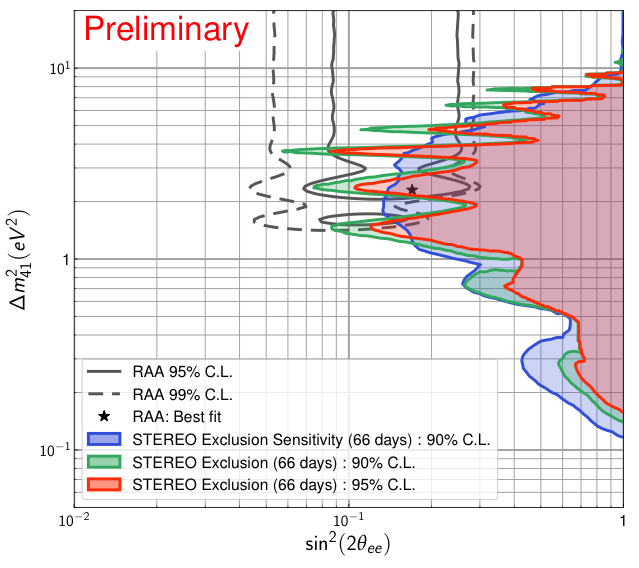Neutrinos are notoriously hard-to-detect elementary particles. They are produced in the core of stars, at particle accelerators, in very high energy phenomena or – as in STEREO – in nuclear reactor cores. Neutrinos do not carry any electric charge and only rarely do they interact with matter. Nowadays, we know of three types: electron neutrinos, muon neutrinos and tau neutrinos. The 20-year old astonishing discovery that neutrinos change type while travelling was awarded the 2015 Nobel Prize.
Are there more than 3 neutrinos? This question was revived in 2011, when researchers noticed that two so far unexplained experimental results (the so-called reactor antineutrino anomaly RAA) could be reconciled if a 4th neutrino existed [2]. With a mass of about 1 eV, this hypothetical particle known as “sterile” neutrino would be heavier than the 3 known neutrino types. Several experiments were designed, among which STEREO, to test the existence of this hypothetical 4th neutrino, and are currently under way.
STEREO is a French-German experiment designed for this goal, measuring very precisely the rates and energy profiles of the neutrinos generated by the nuclear reactor of the Institut Laue-Langevin (ILL) in Grenoble, France. The experiment was devised and is being operated by a team of scientists from Irfu-CEA in Saclay, the Institut Laue-Langevin in Grenoble, the Annecy’s Particle Physics Laboratory (LAPP), the Grenoble’s Subatomic Physics and Cosmology Laboratory (LPSC) and the Max-Planck-Institut für Kernphysik in Heidelberg, Germany (MPIK).
The first results of the STEREO experiment presented at the Moriond conference exclude a significant part of the most likely parameter space expected for a hypothetical 4th neutrino (see Figure below). A 4 times larger data sample expected by the end of 2019 will help to further clarify the case together with other expected results from complementary projects. Thanks to the highly enriched uranium fuel in the ILL core, STEREO will also provide a new benchmark for the neutrino spectrum produced by the fission of 235U, of utmost importance for many other reactor neutrino experiments.
The ILL was particularly engaged in the characterization and preparation of the site for the STEREO detector, in the design of the magnetic shielding, in the safety studies that were validated by the nuclear authorities, and in the installation of the instrument. All ILL divisions contributed to this endeavour. The ILL is involved in the operation of the instrument and in data analysis.

Figure: First results of STEREO. The 4th neutrino can be described by two parameters, the mixing angle sin2(2θee) (horizontal axis) and the difference of the mass squares Δm241 (vertical axis). The difference of the mass squares is related to the frequency of the oscillation between the anti-electronneutrino produced in the reactor core and the hypothetical 4th neutrino. The mixing angle describes the amplitude of this oscillation and is 0 if the 4th neutrino does not exist. In order to resolve the reactor antineutrino anomaly (RAA), the parameter pair (sin2(2θee), Δm241) must be inside the area indicated by the grey lines [2]. Because of the statistical nature of the experiments this statement holds with a certain probability which is indicated by C.L. (Confidence Level). The star shows the parameter pair that would best resolve the RAA [2]. The blue area shows the ideal exclusion sensitivity at the available statistical precision which would be obtained if all STEREO observables correspond exactly to the expectations without 4th neutrino. The first results of STEREO exclude the parameter space indicated by the green and the red area with 90% and 95% C.L., respectively. With additional data these areas will expand to the left. The objective of STEREO is to either fully exclude the RAA region below 4 eV2 or to find the parameters of the 4th neutrino.
[1] 53rd Rencontres de Moriond, Electroweak session. D. Lhuillier's presentation may be viewed here.
[2] G. Mention et al., Phys. Rev. D 83 (2011) 073006

